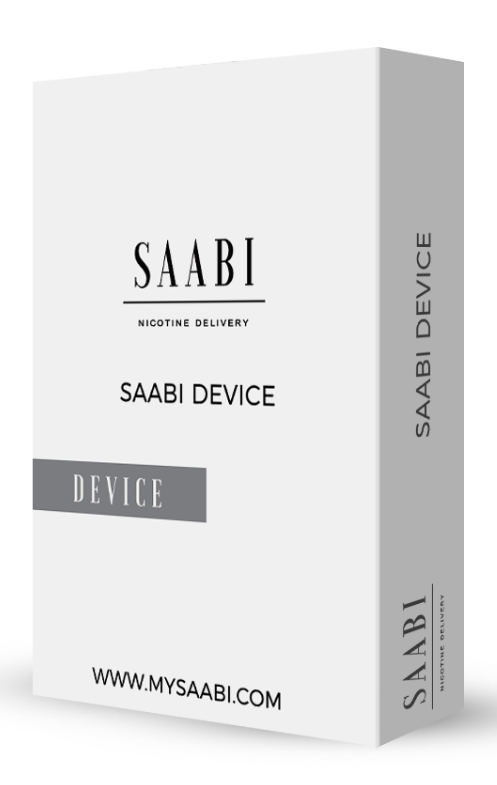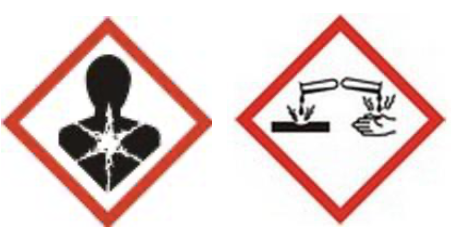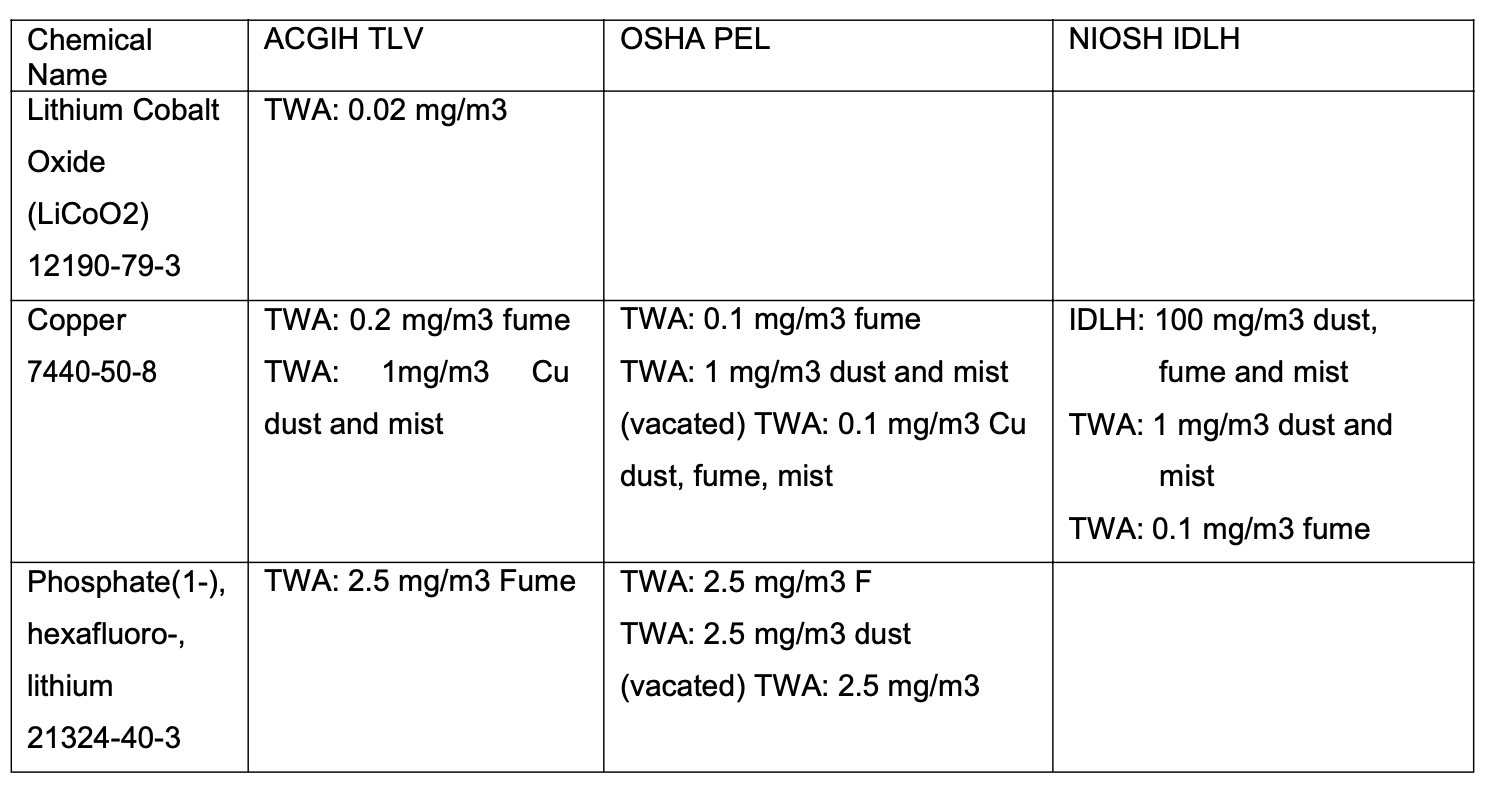SAFETY DATA SHEET
1.1. Product Identifier
SAABI Device Li-ion Battery.
Common name: Li-ion Battery
Model: JS501634
Rating of Battery: 3.7V, 210mAh,0.78Wh
Details of supplier of the safety data sheet:
Supplier name: Dongguan Joysun New Energy Co., Ltd.
Supplier address: NO.21, ShuiBian.lndustrialZone, Hengli Town, Dongguan, Guangdong, China 523470
Email: zhangrong@joysunenergy.com
Emergency telephone number
Telephone: 0769-89178866
Available: Out of working hours
SECTION 2: Composition/Information on Ingredient
Section 3– Hazards Identification
(a) Classification
This chemical is not considered hazardous by the OSHA Hazard Communication Standard . This product
is an article which is a sealed battery and as such does not require an SDS per the OSHA hazard communication standard unless ruptured. The hazards indicated are for a ruptured battery
(b) Material Safety Data Sheet GHS Label elements, including precautionary statements
Signal word:
Emergency Overview
Hazard Statements
Causes skin irritation
Causes serious eye damage
May cause cancer
Suspected of damaging fertility or unborn exposure Extremely flammable aerosol
Contains gas under pressure; may explode if heated
This product is an article which contains a chemical substance. Safety information is given for exposure to the article as sold. Intended use of the product should not result in exposure to the chemical substance. This is a battery. In case of rupture: the above hazards exist.
Appearance Blue Physical State Solid Odor Odorless
Precautionary Statements – Prevention
Wash face, hands and any exposed skin thoroughly after handling. Wear protective gloves/protective clothing/eye protection/face protection Do not breathe dust/fume/gas/mist/vapors/spray
Do not eat, drink or smoke when using this product
Precautionary Statements – Response
Specific treatment (see supplemental first aid instructions on this label) Get medical advice/attention if you feel unwell
Eyes
IF IN EYES: Rinse cautiously with water for several minutes. Remove contact lenses, if present and easy to do. Continue rinsing. Immediately call a POISON CENTER or doctor/physician
Skin
IF ON SKIN: Wash with plenty of soap and water
If skin irritation occurs: Get medical advice/attention Take off contaminated clothing and wash before reuse
Precautionary Statements – Storage
No information available.
Precautionary Statements – Disposal
Dispose of contents/container to an approved waste disposal plant
Hazards not otherwise classified (HNOC)
No information available.
(d) Unknown Toxicity
10% of the mixture consists of ingredient(s) of unknown toxicity.
(e) Other information
No information available.
(f) Interactions with Other Chemicals
No information available.
Section 4- First Aid Measures
The battery is not hazard with eye and skin contact under normal circumstance. In case of the enclosure is damaged, the battery can not be used and touched. It is safety except that the battery is damaged by fire or rupture. The leakage of internal hazardous substance and formation of hazardous substance would occur, take the following measures if contact with the battery.
Skin touch: If there is any unwell reaction, wash thoroughly with soap & water, flush with plenty of water. If irritation persists, seek medical advice.
Eyes touch: Rinse immediately with plenty of water for at least 15 mins. Contact a doctor if symptoms persist.
Inhalation: Remove from exposure site to fresh air. Keep at rest. Obtain medical attention.
Ingestion: Rinse mouth out with water. Seek medical advice immediately.
Self-protection of the first aider: Ensure that medical personnel are aware of the material(s) involved, take precautions to protect themselves and prevent spread of contamination.
Information for doctor
Most important symptoms and effects, both acute and delayed: no further relevant information available.
Indication of any immediate medical attention and special treatment needed: No further relevant information available.
Section 5- Fire Fighting Measures
(a) Extinguishing media
Suitable extinguishing media: Use foam, dry powder or dry sand, CO2 as appropriate.
Unsuitable extinguishing media: No information available.
(b) Special hazards arising from the chemical
Under fire conditions, batteries may burst and release hazardous decomposition products when exposed to a fire situation. This could result in the release of flammable or corrosive materials. Hazardous combustion products: CO, CO2, Metal oxides, Irritating fumes.
(c) Special protective equipment and precautions for fire-fighters
Firefighters must wear fire resistant protective equipment and appropriate breathing apparatus. The staff must equip with filter mask (full mask) or isolated breathing apparatus. The staff must wear the clothes which can defense the fire and the toxic gas. Put out the fire in the upwind direction. Remove the container to the open space as soon as possible. Spray water on the containers in the fireplace to keep them cool until finish extinguishment.
Section 6- Accidental Release Measures
Personal precautions, protective equipment and emergency procedures:
If the battery is released, remove personnel from area until fumes dissipate. Provide maximum ventilation to clear out hazardous gases. The preferred response is to leave the area and allow the vapors to dissipate. Avoid skin and eyes contact or inhalation of vapors. Remove spilled liquid with absorbent and incinerated. If leakage of the battery happens, liquid could be absorbed wit sand, earth or other inert substance and contaminated area should be ventilated meantime.
Environment precautions:
Do not allow product to reach sewage system or any water source.
Inform respective authorities in case of seepage into water course or sewage system. Do not allow to enter sewers/ surface or ground water.
Methods and material for containment and cleaning up:
If battery casing is dismantled, small amounts of electrolyte may leak. Collect all released material in a plastic lined container. Dispose off according to the local law and rules. Avoid leached substances to get into the earth, canalization or waters.
Section 7- Handling and Storage
Precautions for safe handling:
Always follow the warning information on the batteries and in the manuals of devices. Only use the recommended battery types. Keep batteries away from children. For devices to be used by children, the battery casing should be protected against unauthorized access. Unpacked batteries shall not lie about in bulk. In case of battery change always replace all batteries by new ones of identical type and brand. Do not swallow batteries. Do not throw batteries into water. Do not throw batteries into fire. Avoid deep discharge. Do not short-circuit batteries Use recommended charging time and current.
Storage conditions:
If the batteries are subject to storage for such a long term as more than 3 months, it is recommended to recharge the Li-ion battery periodically.
Storage Temperature:
Short period less than 3 months: -20~+45°C, 75%RH Max Long period more than 3 months: +5°C~+35°C, 75%RH Max
Do not storage Li-ion battery haphazardly in a box or drawer where they may short-circuit each other or be short-circuited by other metal objects. Keep out of reach of children. Do not expose Li-Polymer battery to heat or fire. Avoid storage in direct sunlight. Do not store together with oxidizing and acidic materials.
ACGIH TLV: American Conference of Governmental Industrial Hygienists -Threshold Limit Value OSHA PEL: Occupational Safety and Health Administration – Permissible Exposure Limits Immediately Dangerous to Life or Health
Other Exposure Guidelines:
Vacated limits revoked by the Court of Appeals decision in AFL-CIO v. OSHA, See section 15 for national exposure control parameters
(b) Appropriate engineering controls
Engineering Measures: 1. Showers 2. Eyewash stations 3. Ventilation systems
(c) Individual protection measures, such as personal protective equipment
Respiratory protection:
No necessary under normal use. In case electrolyte leakage from the battery, protect hand with chemical resistant rubber gloves. If battery is burning, leave the area immediately. In abuse, use NIOSH approved acid gas filter mask or self-contained breathing apparatus.
Hand protection:
None under normal use. In case of spilling, use PVC, neoprene or nitrile gloves of 15miles (0.015 inch) or thicker.
Eye/Face protection:
None required under normal conditions. Use approved chemical work safety goggles or f ace shield, if handling a leaking or rupture battery.
Skin and boby protection:
No necessary under normal use. Use rubber apron and protective working in case of handling of a rupture battery.
Other protective equipment:
Chemical resistance clothing is recommended along with eye wash station and safety shower should be available. Work hygienic practices: Use good chemical hygiene practice. Wash hands after use and before drinking, eating or smoking.
Wash hands thoroughly after cleaning-up component spill caused by leaking battery. No eating, drinking, or smoking in battery storage area. Launder contaminated cloth before reuse.
Section 9- Physical and Chemical Properties
Information on basic physical and chemical properties
General information
Form: Prismatic
Colour: Blue
Odour: Odourless
Odour threshold: Not available
pH-value: Not available
Change in condition
Melting point/Melting range: Not available
Boiling point/Boiling range: Not available
Freezing point: Not available
Flash point: Not available
Flammability (solid, gaseous): Not available
Auto-Ignition temperature: Not available
Decomposition temperature: Not available
Self-igniting: Product is not self-igniting.
Explosive properties: Risk of explosion by shock, friction, fire or other sources of ignition. Explosion limits
Lower: Not available. Upper: Not available
Oxidizing properties: Not available
Vapour pressure: Not available
Density: Not available
Relative density: Not available
Vapour density: Not available
Evaporation rate: Not available
Solubility in / Miscibility with water: Not available
Partition coefficient (n-octanol/water): Not available. Viscosity
Dynamic: Not available.
Kinematic: Not available
Other information: No further relevant information available.
Section 10- Stability and reactivity
(a) Reactivity
Stable under recommended storage and handling conditions.
(b) Chemical stability
Stable under normal conditions.
(c) Possibility of hazardous reactions
When heated above 150°C the risk of rupture occurs. Due to special safety construction, rupture implies controlled release of pressure without ignition.
(d) Conditions to avoid
Do not subject Li-ion Battery to mechanical shock. Keep away from open flames, high temperature.
(e) Incompatible materials
Strong oxidizer, strong acid.
(f) Hazardous decomposition products
Under fire conditions, the electrode materials can form carcinogenic nickel and cobalt oxides.
Section 11- Toxicological information
(a) Information on the likely routes of exposure
Inhalation: Inhalation of a large number of vapors or fumes released due to heat may cause respiratory. Ingestion: Ingestion of battery contents may cause mouth, throat and intestinal burns and damage. Skin contact: Contact with battery electrolyte may cause burns and skin irritation.
Eye contact: Contact with battery electrolyte may cause burns. Eye damage is possible.
Under normal conditions (during charge and discharge) release of ingredients does not occur. If accidental release occurs see information in section 4. Swallowing of a battery can be harmful. Call the local Poison Control Centre for advice and follow-up.
(b) Information on toxicological characteristics
Acute toxicity: No data available.
Skin corrosion/irritation: The liquid in the battery irritates.
Serious eye damage/irritation: The liquid in the battery irritates.
Respiratory sensitization: The liquid in the battery may cause sensitization to some person.
Skin sensitization: The liquid in the battery may cause sensitization to some person.
Carcinogenicity: Cobalt and Cobalt compounds are considered to be possible human carcinogen(s).
Germ Cell Mutagenicity: No data available.
Reproductive Toxicity: No data available.
STOT-Single Exposure: No data available.
STOT-Repeated Exposure: No data available.
Aspiration Hazard: No data available.
Sensitization: No data available.
Mutagenic Effects: No data available.
Carcinogenicity: No data available.
Reproductive Toxicity: No data available.
Chronic Toxicity: No data available.
Target Organ Effects: No data available.
Aspiration Hazard: No data available.
Section 12- Ecological Information
Toxicity
Aquatic toxicity: No further relevant information available.
Persistence and degradability: No further relevant information available.
Behaviour in environmental systems: No further relevant information available
Bioaccumulative potential: No further relevant information available.
Mobility in soil: No further relevant information available.
Additional ecological information
General notes:
Water hazard class 2 (German Regulation) (Self-assessment): hazardous for water Do not allow product to reach ground water, water course or sewage system. Danger to drinking water if even small quantities leak into the ground.
Results of PBT and vPvB assessment
PBT: Not applicable.
vPvB: Not applicable.
Other adverse effects: No further relevant information available.
Section 13- Disposal Considerations
Waste disposal methods:
- Disposal of the battery should be performed by permitted, professional disposal firms knowledgeable infederal, state or local requirements of hazardous waste treatment and hazardous waste transportation.
- Incineration should never be performed by battery used. The batteries contained recyclable materials.Recycling options available in your local area should be considered when disposing of this product, through licensed waste carrier.
- The battery should have their terminal insulated in order to prevent short circuits during transportation to the disposal site.
Note: Consult your local or region authorities, disposal maybe subject to national, state, or local laws.
Section 14 – Transport Information
According to PACKING INSTRUCTION 965 ~ 967 of IATA DGR 61th Edition for transportation, the special provision 188 of IMDG (inc Amdt 39-18). The batteries should be securely packed and protected against short-circuits. Examine whether the package of the containers are integrate and tighten closed before transport. Take in a cargo of them without falling, dropping, and breakage. Prevent collapse of cargo piles. Don’t put the goods together with oxidizer and chief food chemicals. The transport vehicle and ship must be cleaned and sterilized otherwise it is not allowed to assemble articles. During transport, the vehicle should prevent exposure, rain and high temperature. For stopovers, the vehicle should be away from fire and heat sources. When transported by sea, the assemble place should keep away from bedroom and kitchen, and isolated from the engine room, power and fire source. Under the condition of Road Transportation, the driver should drive in accordance with regulated route, don’t stop over in the residential area and congested area. Forbid to use wooden, cement for bulk transport.
UN-Number
ADR, IMDG, IATA UN3480 or UN3481
UN proper shipping name
ADR LITHIUM ION BATTERIES
IMDG, IATA LITHIUM ION BATTERIES
Transport hazard class(es)
ADR, IMDG, IATA
Class: 9 Miscellaneous dangerous substances and articles.
Label: 9
Packing group
ADR, IMDG, IATA : II
Marine pollutant:
No
Special precautions for user:
Warning: Miscellaneous dangerous substances and articles.
Danger code (Kemler): —
Transport in bulk according to Annex II of MARPOL73/78 and the IBC Code:
Not Applicable
UN “Model Regulation”:
UN3480 or UN3481, LITHIUM ION BATTERIES, 9, II.
Transport Fashion:
Product after passing the package can be applied to air, sea, railway and road transport.
Section 15- Regulatory information
OSHA hazard communication standard
…………………………………….. Hazardous ………………..?…………………….. Non-hazardous
Section 16- Other Information
Note: The above information is based on the data of which we are aware and is believed to be correct as of the data hereof. Since this information may be applied under conditions beyond our control and with which may be unfamiliar and since data made available subsequent to the data hereof may suggest modifications of the information, we do not assume any responsibility for the results of its use. This information is furnished upon condition that the person receiving it shall make his own determination of the suitability of the material for his particular purpose.








